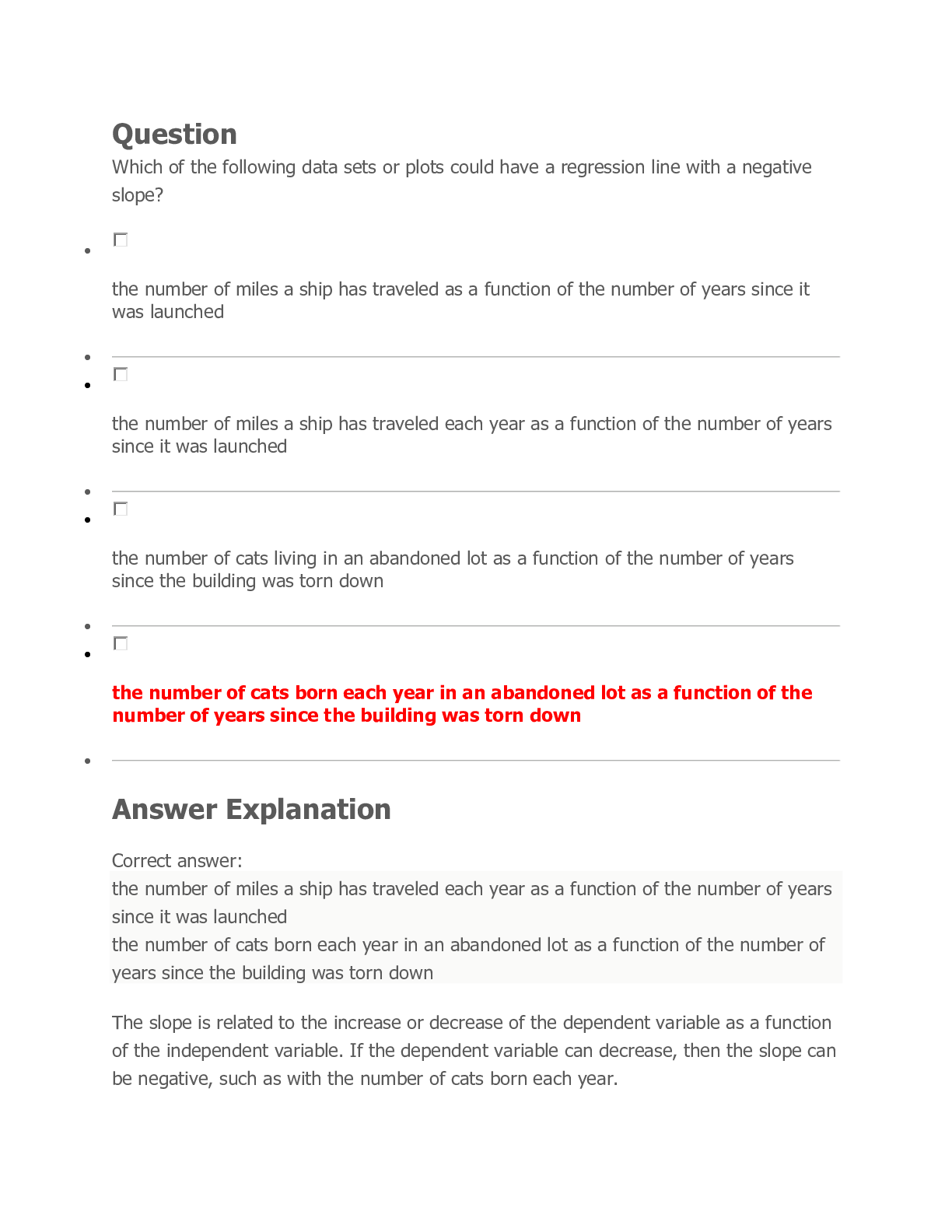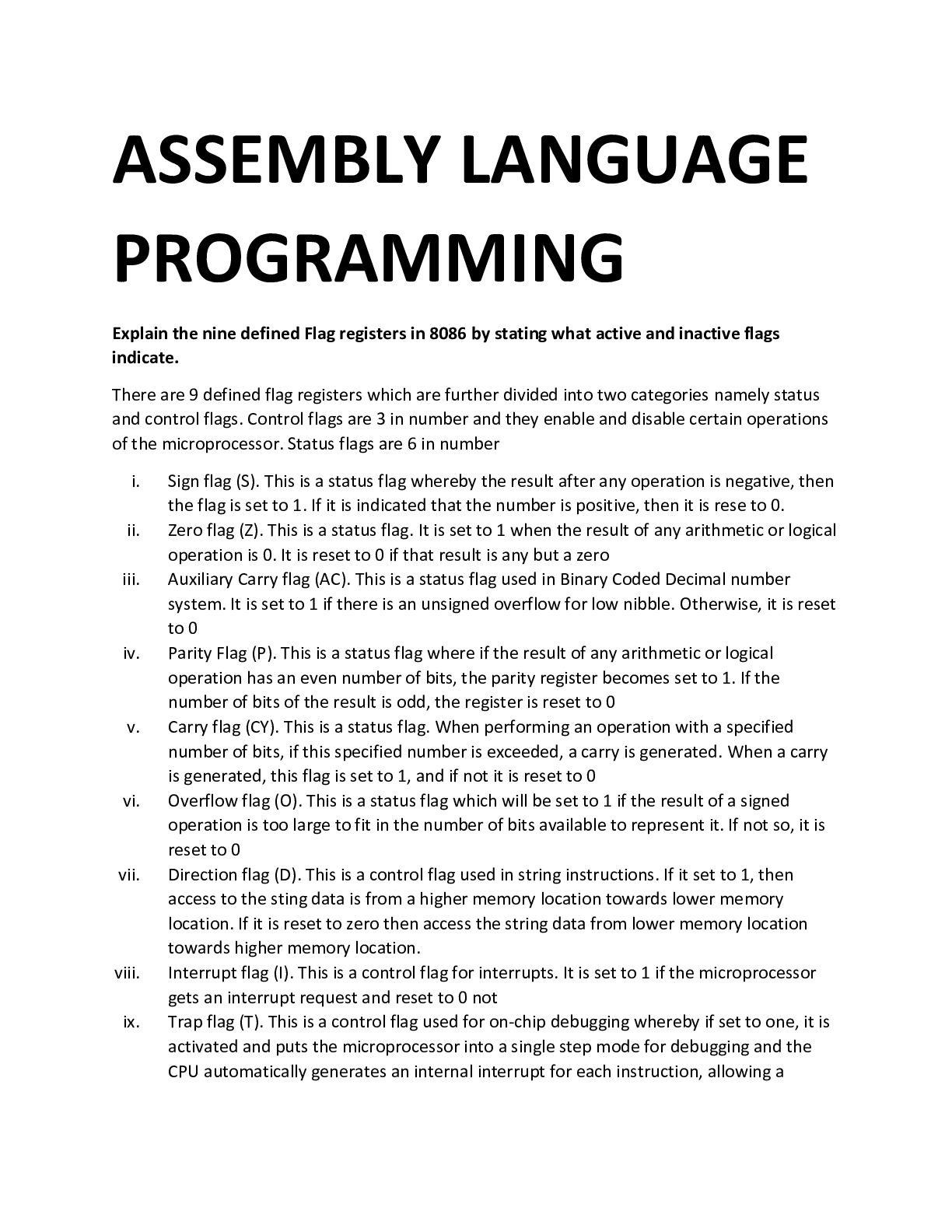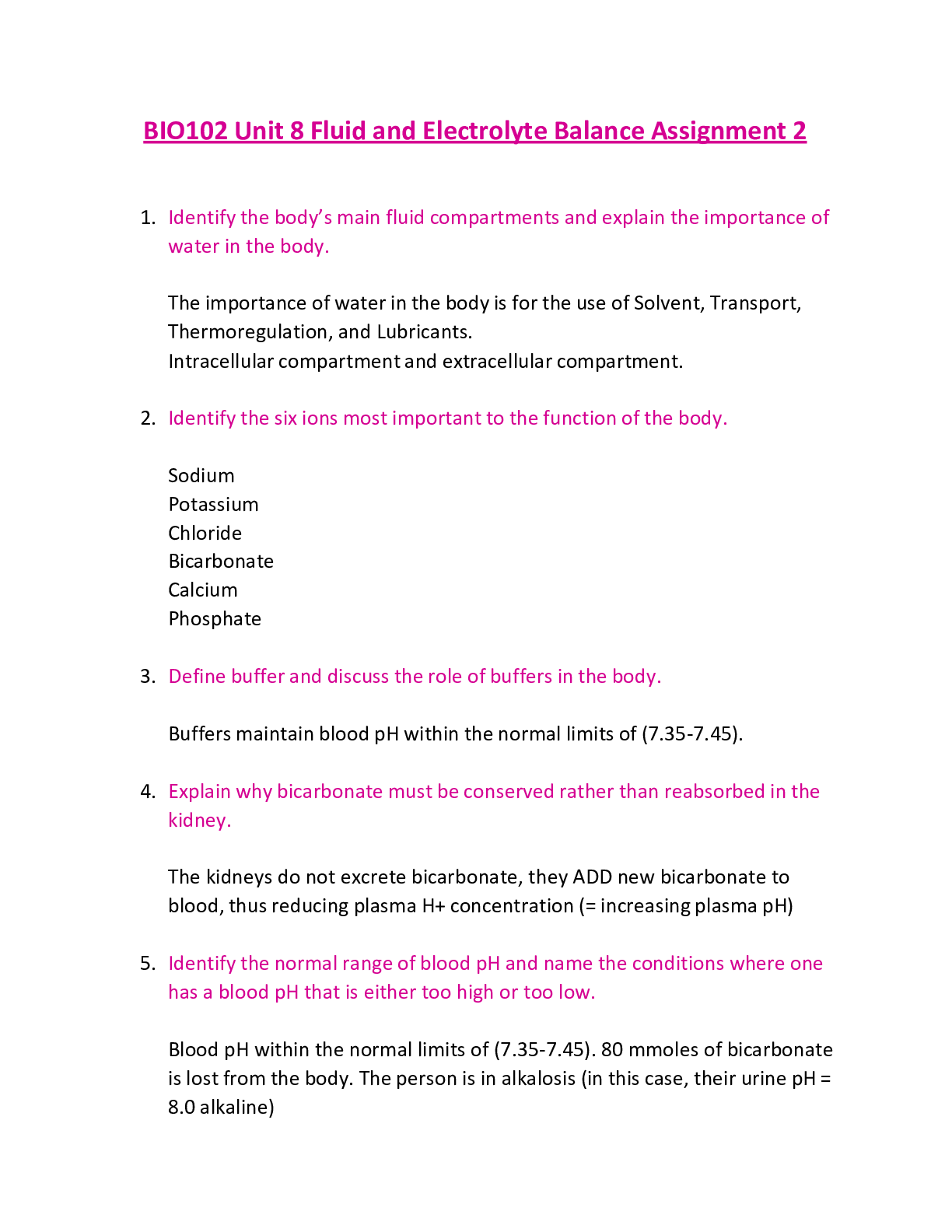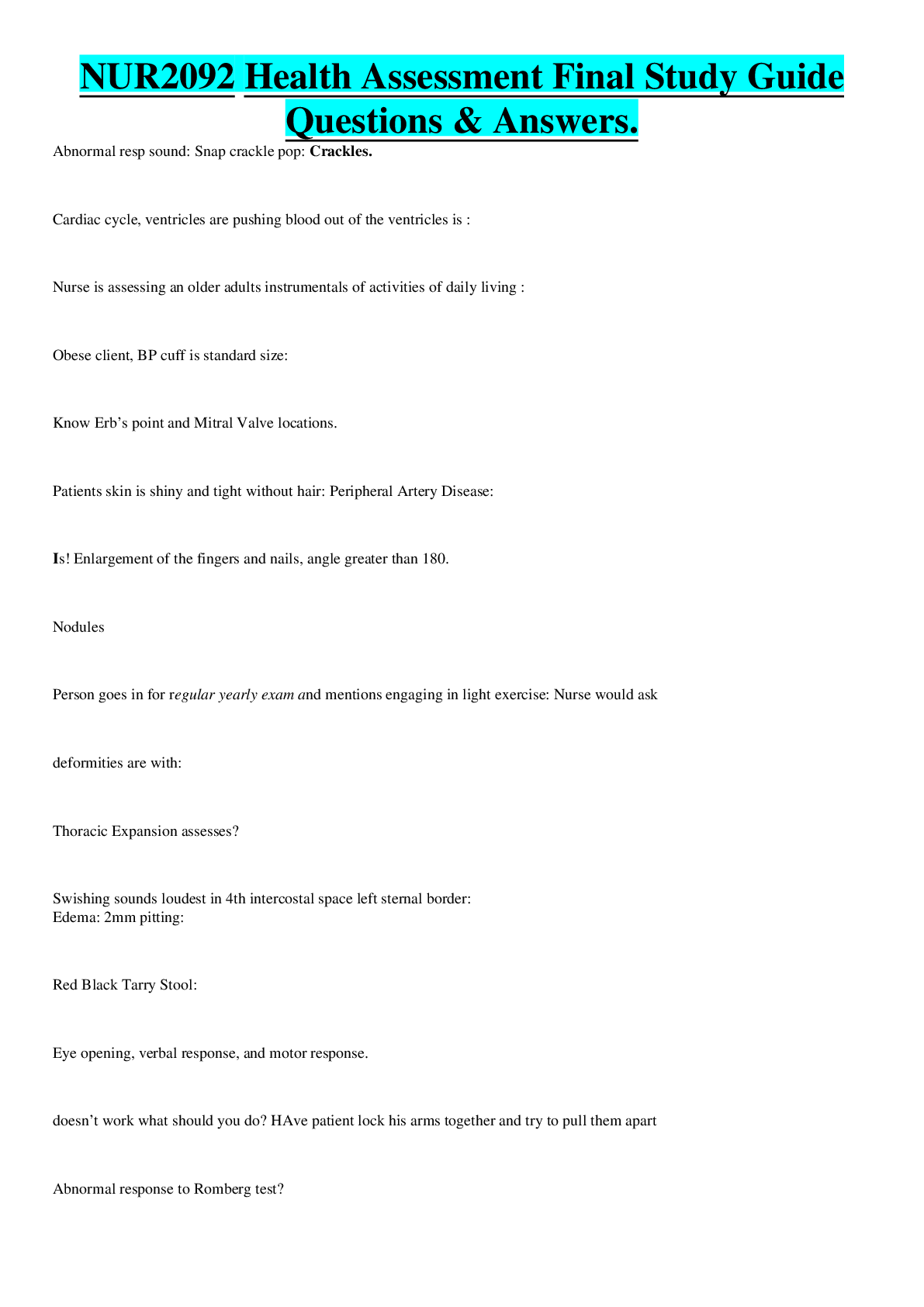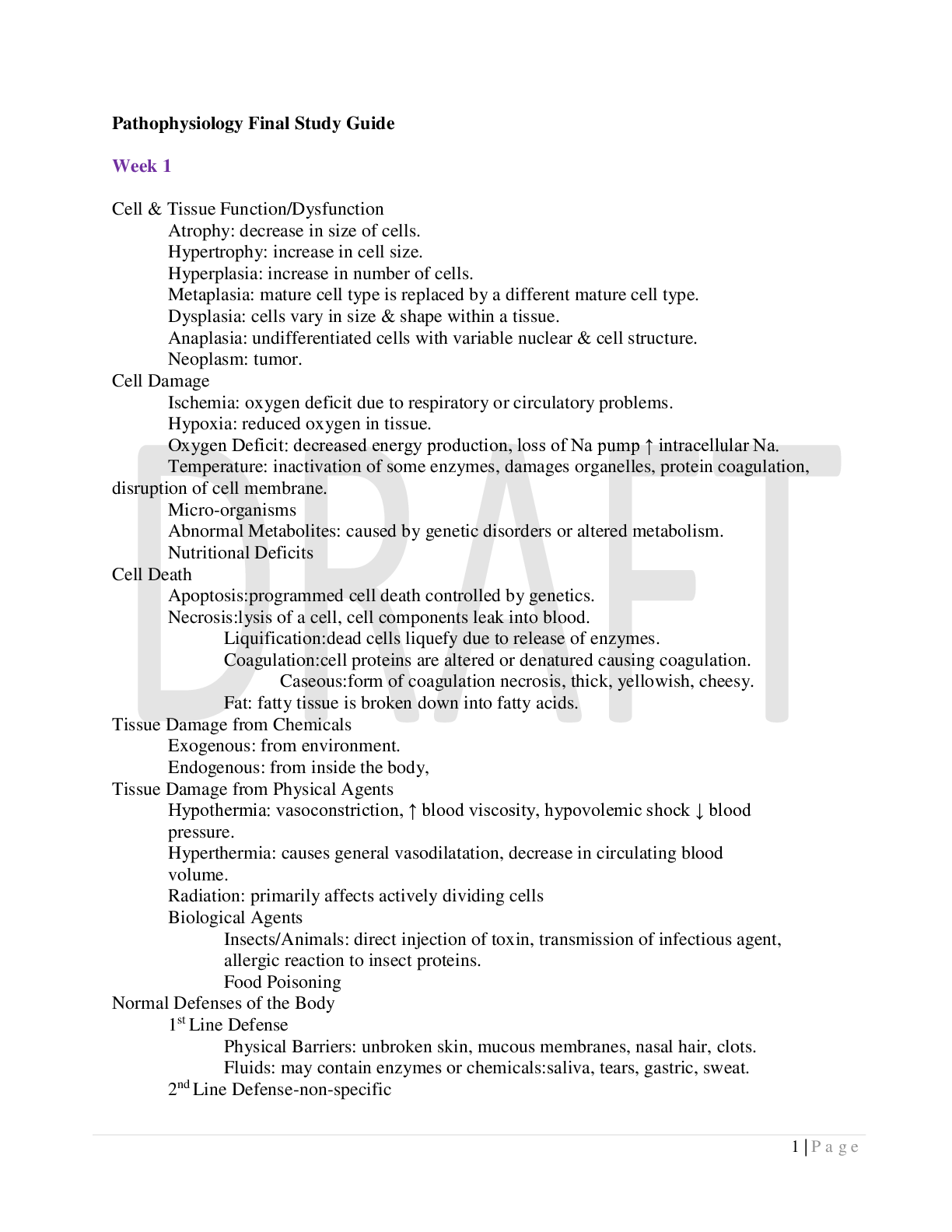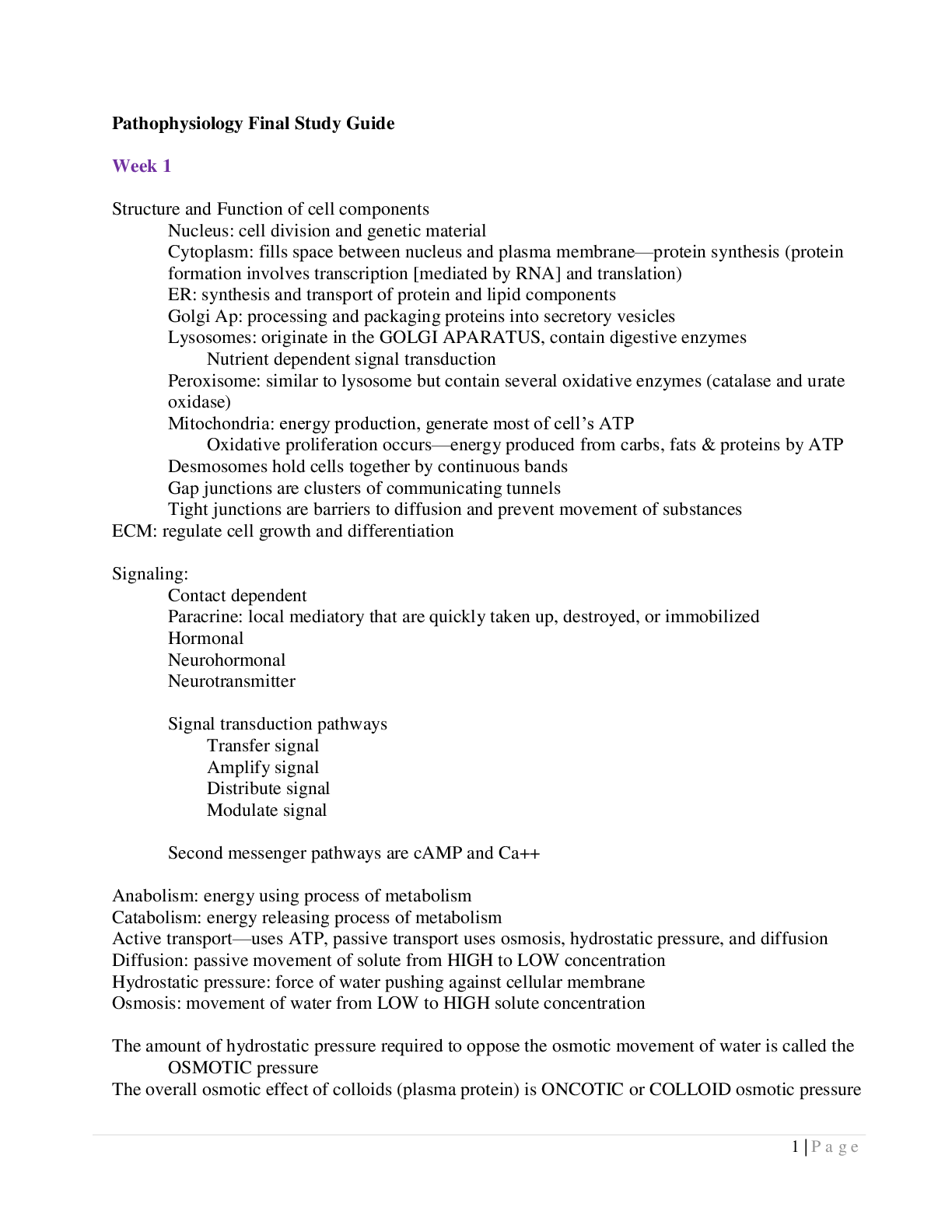*NURSING > QUESTIONS & ANSWERS > NR 509 Final Study Guide (All)
NR 509 Final Study Guide
Document Content and Description Below
NR 509 Final Study Guide (A guaranteed) NR 509 Final Study Guide Behavior/Mental Health Assessment and Modification for Age 1. Assessment: a. b. Many mental health disorders are masked by other c... linical conditions; 20% of primary care outpatients have mental disorders(50-70% go undetected and untreated) c. Physical symptoms account for approx 50% of office visits d. ⅓ of physical symptoms are unexplained; in 20-25% those symptoms become chronic e. Symptoms and Behaviors: i. Sorting symptom is a challenge; can be unexplained symptoms 1. Patients who have unexplained symptoms depression and anxiety exceeds 50% ii. Physical or “somatic” symptoms account for 50% of U.S. office visits 1. Pain, fatigue, palpitations, GI symptoms, sexual dysfunction, dizziness or loss of balance 2. Symptoms that present as clusters are called “functional syndromes” such as IBS, fibromyalgia, chronic fatigue, TMJ disorder, and multiple chemical sensitivity 3. The presence of symptom overlap is high in the common functional syndromes such as fatigue, headache, sleep disturbance, pain, GI upset iii. Patients with unexplained and somatic symptoms are often frequent users of the health care system and termed “difficult patients” iv. Patients with symptoms that last longer than 6 weeks are recognized as chronic and should be screened for depression and anxiety. a. A two tiered approach is recommended for screening. A brief screening with questions that yield high sensitivity then a more detailed investigation when indicated V. Patient who warrant a mental health screening include: 1. medically unexplained physical symptoms 2. Multiple physical or somatic symptoms 3. High severity of the presenting somatic symptom 4. Chronic pain 5. Symptoms longer than 6 weeks 6. Physician stating “a difficult encounter” 7. Recent stress 8. Low self-rating of overall health 9. Frequent use of health care services 10.Substance abuse 2. Adjustment for age: A. Elderly: a. Older adults may complain of memory problems but usually is due to benign forgetfulness. b. Older adults retrieve and process data more slowly and take longer to learn new information c. Older adults may have slower motor responses and their ability to perform complex task may diminish d. It is important to try to distinguish age-related changes from manifestations of mental disorders e. Older patients are more susceptible to delirium which could be the first sign of infection, problems with medications, or impending dementia B. Newborn: a. Assess mental status of a newborn by observing newborn activities i. Look at human faces and turn to a parents voice ii. Ability to shut out repetitive stimuli(such as a vacuum) iii. Bond with caregiver iv. self-soothe b. Assess for mental status during alert periods · Normal VS. Abnormal Findings and Interpretation 1. Attention: a. Normal: able to focus and concentrate b. Abnormal: inattentive and easily distracted 2. Memory a. Normal: able to repeat immediate repetition of material given; b. Abnormal: unable to repeat recent events 3. Orientation: a. Normal: aware of person, place, and time b. Abnormal: unaware of person, place, or time 4. Perception: a. Normal: Sensory awareness of objects in the environment b. Abnormal: hallucinations 5. Thought Process: a. Normal: logic, coherent, and relevant thoughts b. Abnormal: irrational thought 6. Thought Content: a. Normal: Has insight and judgement b. Abnormal: impaired judgement and irrational behaviors 7. Insight a. Normal: able to distinguish normal vs. abnormal b. Abnormal: Unable to distinguish normal vs. abnormal 8. Judgement a. Normal: good judgement b. Abnormal: poor or bad F· Speech Patterns 1. Note characters of speech a. Slow speech= depression b. Accelerated and Loud speech= mania c. Articulation: are the words clear and distinct; does the speech have a nasal quality i. Dysarthria(defective articulation) ii. Dysphonia-impaired volume, quality or pitch iii. Aphasia-disorder of speech d. Fluency: reflects rate, flow and melody of speech and the content and words used. Abnormalities include i. Hesitancies and gaps in flow ii. Disturbed inflections such as monotone iii. Circumlocutions, in which phrases or sentences are substituted for a word the person cannot think of ie. “what you write with” instead of “pen” iv. Paraphrasias, words are malformed(“I write with a den”), wrong (I write with a bar) or made up (I write with a dar) v. Fluency abnormalities indicate aphasia from cerebrovascular infarction. vi. Aphasia may be receptive(impaired comprehension with fluent speech) OR expressive(with preserved comprehension and slow nonfluent speech) vii. A person who can write a correct sentence does NOT have aphasia e. Testing for Aphasia i. Word Comprehension: Ask the patient to follow one-stage commands such as “Point to your nose” ii. Repetition: Ask the patient to repeat a phrase of one-syllable words “ No ifs, ands, or buts” iii. Naming: Ask the patient to name the parts of a watch iv. Reading Comprehension: Ask the patient to read a paragraph aloud v. Writing: Ask the patient to write a sentence · Mental Status Examination 1. Five components of the mental status examination a. Appearance and Behavior i. Note level of consciousness: is the patient awake and alert, does the patient understand your questions and respond appropriately 1. If the patient does not respond then speak to the patient by name in a loud voice 2. Lethargic patients are drowsy but open their eyes and look at you, respond to questions, then fall back asleep 3. Obtunded patients open their eyes and look at you but respond slowly and are somewhat confused ii. Note posture and motor behavior:does the patient sit or lie quietly or prefer to walk around; note the pace, range, and type of movement 1. Look for tense posture, restlessness, and anxious fidgeting; the crying, pacing, and hand wringing of agitated depression 2. The hopeless slumped posture and slowed movement of depression 3. The agitated and expansive movements of manic episodes iii. Note Dress, Grooming, and Personal hygiene: how is the patient dressed, clean and presentable?, how is grooming compared to those of similar age, compare one side to the other 1. May deteriorate in depression, schizophrenia, and dementia 2. Excessive fastidiousness may be seen OCD 3. One-sided negligence may result from a lesion in the opposite parietal cortex; usually the non-dominant side iv. Note facial expression: observe the face at rest and during conversation; are changes in expression appropriate 1. Note Expressions of anxiety, depression, apathy, anger, elation, or facial immobility in parkinsonism v. Manner, Affect, and Relationship to People and Things: assess the patients external expression of the inner emotional state(Affect). Is the affect appropriate to topics being discussed?, seem exaggerated at points, labile, blunted, or flat? 1. Paranoia= anger, hostility, suspiciousness, or evasiveness 2. Mania= elation and euphoria 3. Schizophrenia=flat affect with remoteness 4. Dementia and Anxiety or Depresion= apathy(dulled affect with detachment and indifference) 5. Hallucinations=schizophrenia, alcohol withdrawal, and systemic toxicity b. Speech and Language= SEE ABOVE in language patterns c. Mood: Ask patient to describe his/her mood, including usual level and fluctuations related to life events i. Moods range from sadness and melancholy, contentment, joy, euphoria, and elation; anger and rage, anxiety and worry, to detachment and indifference ii. If you suspect depression, assess its severity and any risk of suicide iii. It is your responsibility as the provider to ask directly about suicidal thoughts. This may be the only way to uncover suicidal ideation and plans that launch immediate intervention and treatment d. Thought and Perception: i. Thought Process: assess the logic, relevance, organization, and coherence of the patients thought process throughout the interview; does speech progress logically?, listen for patterns of speech that suggest disorders; Variations and Abnormalities include: 1. Circumstantiality: speech with unnecessary detail, indirection, and delay in reaching the point; Occurs in patients with obsessions 2. Derailment: “tangential” speech with shifting topics that are loosely connected or unrelated; seen in schizophrenia, manic episodes, and other psychotic disorders 3. Flight of Ideas: a continuous flow of accelerated speech with abrupt changes from one topic to the next; most frequently seen in manic episodes 4. Neologisms: Invented or distorted words, or words with new and highly idiosyncratic meanings; observed in schizophrenia, psychotic disorders, and aphasia 5. Incoherence: Speech that is incomprehensible and illogical, with lack of meaningful connections, abrupt changes in topic, or disordered grammar or word use. Flight of ideas, when severe, may produce incoherence. Seen in severe psychotic disturbances usually schizophrenia 6. Blocking: Sudden interruption of speech in mid sentence or before the idea is completed, attributed to “losing the thought.” Blocking occurs in normal people. May be striking in schizophrenia 7. Confabulation: Fabrication of facts or events in response to ques- tions, to fill in the gaps from impaired memory. Seen in Korsakoff syndrome from alcholism 8. Perseveration: Persistent repetition of words or ideas Occurs in schizophrenia and other psychotic disorders 9. Echolalia:Repetition of the words and phrases of others. Occurs in manic episodes and schizophrenia 10.Clanging: Speech with choice of words based on sound, rather than meaning, as in rhyming and punning. For example, “Look at my eyes and nose, wise eyes and rosy nose. Two to one, the ayes have it!” Seen in schizophrenia and manic episodes [Show More]
Last updated: 2 years ago
Preview 1 out of 62 pages

Buy this document to get the full access instantly
Instant Download Access after purchase
Buy NowInstant download
We Accept:

Reviews( 0 )
$14.00
Can't find what you want? Try our AI powered Search
Document information
Connected school, study & course
About the document
Uploaded On
Oct 23, 2020
Number of pages
62
Written in
Additional information
This document has been written for:
Uploaded
Oct 23, 2020
Downloads
0
Views
104

